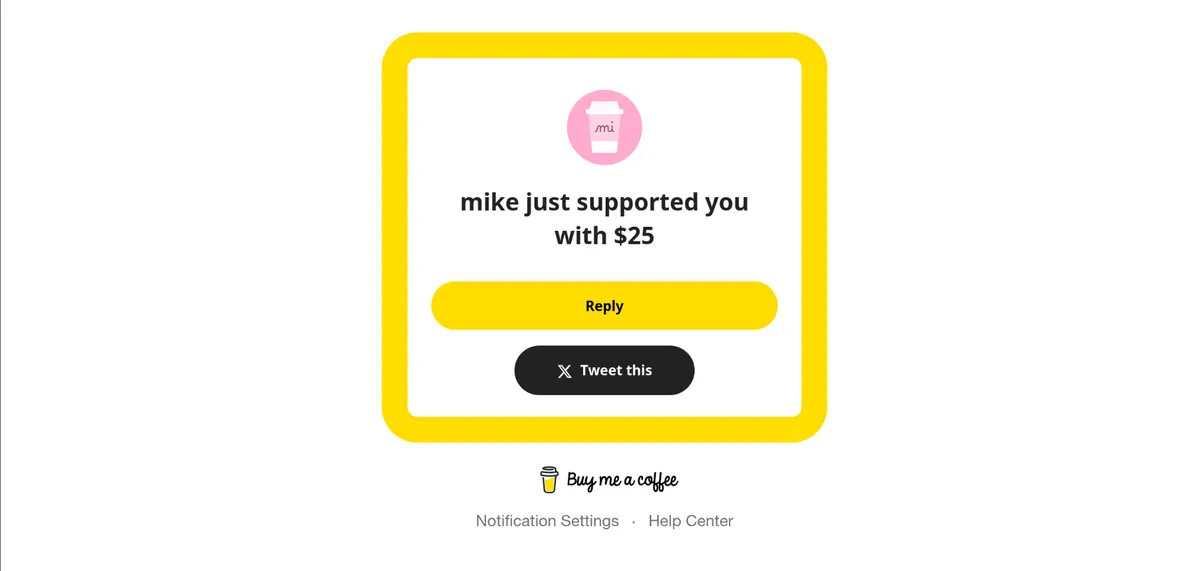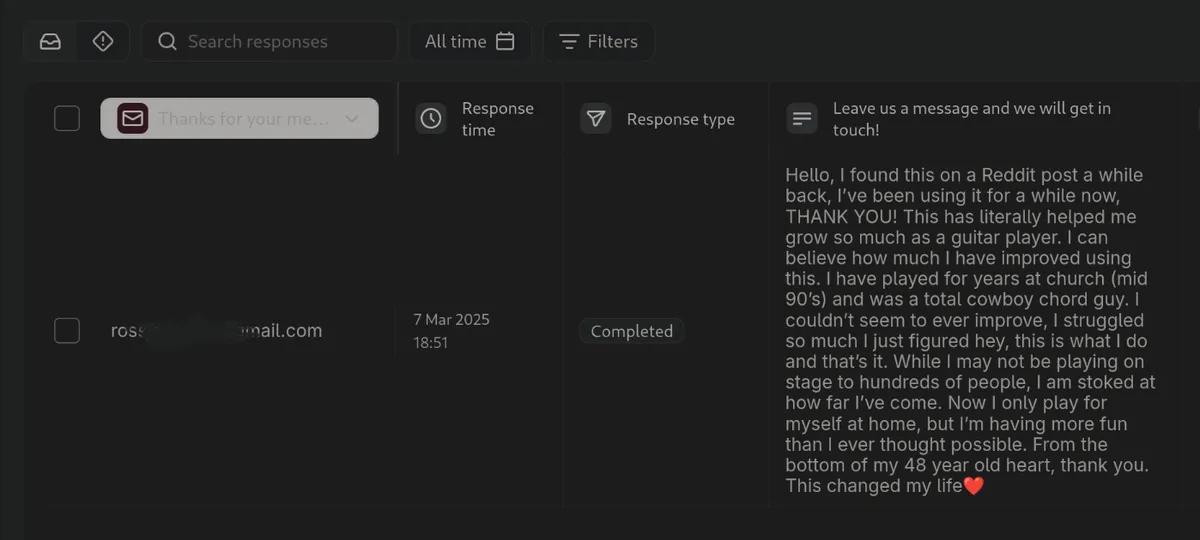an app i built made the first money
Sixteen months ago, Armaan and I launched Guitartonic and left it to run, hoping to return to it when we had time between other projects. I had almost forgotten it existed when, on a sunny Monday morning, I woke up to a foreign email. Someone had donated $25 to my Buy Me a Coffee link.
the app i forgot about
We were thrilled to launch the app. We both played guitar at a similar level — except Armaan shredded electric solos, and I played Russian folk with elaborate tunes. Another difference was that he knew pentatonic scales. Despite having played guitar for sixteen years, the only scales I knew, on the other hand, were kitchen scales. Both of us wanted to improve our guitar solos, but we didn't know how. There was, of course, music theory. But music theory is hard, and neither of us wanted to slog through PDFs full of graphs, formulas, and alien notations.
We didn't want hard. We wanted easy.
When the app was done, we announced it on Hacker News, the best platform for geeks like us. We expected thousands of upvotes. After all, we were geniuses, and the app was a killer. Instead, we got three upvotes. And two comments from friends who didn't even play guitar.

Looking at the website analytics was like watching a lone tumbleweed roll through the desert, so we quickly lost motivation to improve the app. We made it stable and fixed critical bugs, but we didn't want to turn it into a full-blown app until we saw more users. And since we didn't have enough users, we would have had to rely solely on our own product vision. That's seldom a good strategy.
We didn’t market Guitartonic apart from sharing the link on a few guitar subreddits. After two days, we had thirty people on the website. Plus, it wasn’t the niche audience we wanted — guitarists learning scales — but a mix of friends, beginner guitarists, and random folks. At that point, we decided to move on with our lives, and since Guitartonic cost us nothing to run, we kept it online. Eventually, we forgot it was still running — until almost two years later, when I saw an email:

I knew nothing about this Mike besides their email address. Who was this person, and why did they donate? Was it because they loved the app, or simply to support an entrepreneur?
But none of it mattered. What did is that the money was in my account. Twenty-five dollars is hardly enough for anything. After taxes and splitting it with my cofounder, it would cover exactly one coffee — but not much else. And yet, only a founder who earned nothing but friends' jokes for two years could understand the value of every single cent of those twenty-five dollars. It's not just a coffee. It's a sign of trust, of appreciation.
new motivation
The same morning, we went to check Google Analytics. To my surprise, there were people using Guitartonic daily. But more than about the number, we were excited about the average engagement time. It was four minutes — not bots indexing the website, but actual users trying out the app. They didn't just press the play button, realize it sucks and leave. No. They played it and stuck for at least one or two songs.
A session length of four to ten minutes was a promising sign. I also went to check the contact forms, in case we missed any feedback, and found a comment dated two months ago. The person's name wasn't Mike. And the message said:
Hello, I found this on a Reddit post a while back, I’ve been using it for a while now, THANK YOU! This has literally helped me grow so much as a guitar player. I can believe how much I have improved using this. I have played for years at church (mid 90’s) and was a total cowboy chord guy. I couldn’t seem to ever improve, I struggled so much I just figured hey, this is what I do and that’s it. While I may not be playing on stage to hundreds of people, I am stoked at how far I’ve come. Now I only play for myself at home, but I’m having more fun than I ever thought possible. From the bottom of my 48 year old heart, thank you. This changed my life ❤️

Reading that comment meant we had something of great value to a few people, which is the one thing all startup founders look for. A product that a niche audience wants. Paul Graham once wrote, 'Do things that don't scale'.
startups face three challenges
The biggest problem with most startups is that founders fail to find the first user. That one person who loves the product so much they want to tell all their friends about it. They want to give feedback, and they want to give money.
B2C startups face three challenges:
- no users
- users come but don't stay
- users stay but not long
Proving value with our app was the first step in a long journey. But even the best products in the world stay hidden without marketing. Guitartonic still needs a sustainable way to get users without begging Redditors to try our app. It needs a marketing channel that works. Secondly, even if people come, how do we engage them, so they stick around long enough for the LTV > CAC 1 formula to make sense? While the second problem is common and can be mitigated, the first is what makes or breaks a successful idea. Without a sustainable way to get a user, there's no sustainable way to run a business.
How do you encourage users to come back the next day? The next week? A typical issue in the education sector is that users learn in levels. Even if they find your tool helpful for learning, it's only a matter of time before they'll need a more advanced strategy, and at that point they will start looking for a different tool. Think of Duolingo. Even the app that makes you keep your daily streak for years, loses 40% of their customers the next month2. All apps have churn, but the length of user engagement varies.
If you have a continuous flow of users — a sustainable marketing channel — no matter how bad your product is, the users will always drive it in the right direction by giving you feedback and suggesting features. But if you don't know how to get the users, nothing else will matter.
future of guitartonic
I am motivated to spend more time on Guitartonic to try to scale it. The options seemed limited initially, but only because we haven't thought about it much. YouTube, Twitter, guitar forums, Reddit, HackerNews, Instagram — you name it. Even this blog. As I get more people read my posts, the more end up on the Guitartonic's website.
We are optimistic about the future of this little tool because it proved valuable. Even if it's not valuable enough to make millions, for the first time I am not chasing money. My other startup, Blymp, brings enough to live sustainably in Asia — and that's what I am planning to do in the next months — while letting me work on more fulfilling ideas. The money isn't the goal but a byproduct of the value I bring to my users. And bringing value is exactly what I want to focus on.
I'll finish with examples of heartwarming feedback we've got so far:



The LTV:CAC ratio compares the lifetime value of a customer (LTV) to the cost of acquiring that customer (CAC). A healthy ratio is typically around 3:1, indicating that for every dollar spent on acquiring a customer, the business earns three dollars in return, which is essential for sustainable growth and profitability.↩
https://sensortower.com/blog/duolingos-gamified-success-a-language-learning-triumph?utm_source=chatgpt.com↩